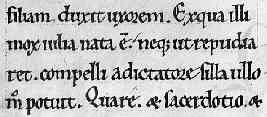 |
|
Gothic
Variations |
| During
the 11th century, Caroline
minuscule as written in northern France and Belgium developed a new
form, becoming more compressed and angular. Letters were constructed from
broad vertical strokes, the ends of letter shafts consisting of slanting
hair strokes, or feet. This was the first stage in the development of
Gothic book
hands. Some, but not all, paleographers
distinguish this as a separate phase called protogothic.
|
|
In
the 12th century, protogothic spread across a wider area of France and
over to England. It began to spread more slowly into Germany. It was predominantly
a book hand, although charters
in this style of script
exist. It is the earliest form of Gothic textura,
so called because of its resemblance to a woven textile. It is a minuscule script, also known as Gothic textualis. |
|
|
Protogothic
book script from France, from a volume of Gaius Suetonius Tranquillus, Life
of Caesar from the late 12th century (British Library Egerton 3055,
f.2), by permission of the British Library. |
|
|
In
northern Italy in the 12th century, book hand developed a similar angularity
in the formation of letters, but retained a broader and more rounded appearance.
This script is known as rotunda
and was retained until the 15th century. Scripts of this type were adopted
in parts of southern France and Spain. |
 |
12th
century script of the rotunda style from the Melissande Psalter (British Library,
Egerton 1139, f.210), by permission of the British Library. |
| The above example is from a codex originating in the Holy Land, and has miniatures in Byzantine style by a Greek artist, but the script is an Italian style rotunda. |
|
While
the adoption of Caroline minuscule was a standardising process across
many countries and different types of documents, the development of the
Gothic family of scripts was a differentiating process in which a range
of scripts of great diversity of form developed for a variety of purposes. |
|
Although
formal Gothic textura was not generally used for documents, changes and
diversification appeared around this time in the scripts used for legal
and administrative purposes. In the English chancery
during the 12th century a variety of styles developed. Some were compressed
and angular, almost spiky. Others were neat and rounded with long calligraphic
ascenders and
descenders,
similar to scripts used in various European centres for diplomas
and in the papal curia, replacing the older curialis. |
 |
|
A
sample of protogothic document hand of the spiky variety, from a 12th century
charter (British LIbrary, add. charter 47424), by permission of the British
Library. |
 |
|
Calligraphic
document hand of the 13th century, from a private charter (British Library,
add charter 20592), by permission of the British Library. |
|
The
continuing development of the Gothic family of scripts involved a series
of processes of diversification and reintegration, as the competing needs
for impressive and legible writing and that for speed of transcription
interacted with mannerisms of style. |
|
continued |
 previous page previous page |
 History
of Scripts History
of Scripts |
 What
is Palaeography? What
is Palaeography? |
|
 |
 |
 |

